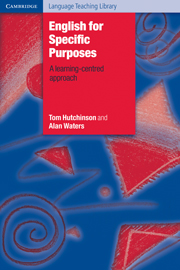Book contents
6 - Needs analysis
Published online by Cambridge University Press: 03 May 2010
Summary
From each according to his abilities, to each according to his needs.
(Karl Marx)We have defined ESP as an approach to course design which starts with the question ‘Why do these learners need to learn English?’ But it could be argued that this should be the starting question to any course, General or ESP. All courses are based on a perceived need of some sort. Otherwise why would English find its way on to a school or college timetable: someone at some time must have decided there was a need for it. What then, in the terms of our definition, is the difference between ESP and General English?
The answer to this very reasonable question is ‘in theory nothing, in practice a great deal’. It is often argued that the needs of the General English learner, for example the schoolchild, are not specifiable. This is an assumption that owes more to institutional inertia and the weight of tradition than to any reality, but it is a powerful force nevertheless. In fact, this is the weakest of all arguments, because it is always possible to specify needs, even if it is only the need to pass the exam at the end of the school year. There is always an identifiable need of some sort.
What distinguishes ESP from General English is not the existence of a need as such but rather an awareness of the need.
- Type
- Chapter
- Information
- English for Specific Purposes , pp. 53 - 64Publisher: Cambridge University PressPrint publication year: 1987
- 3
- Cited by



